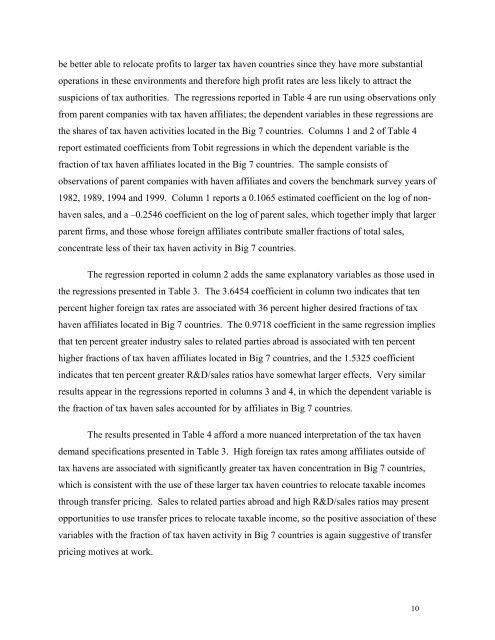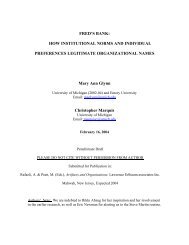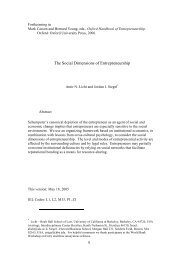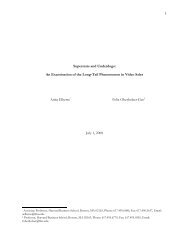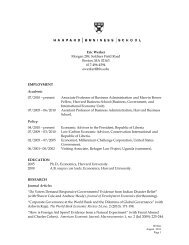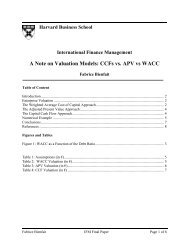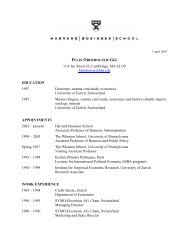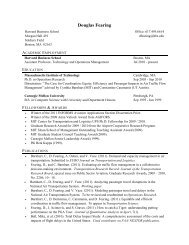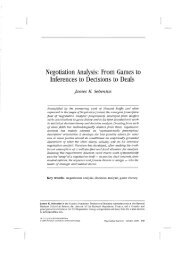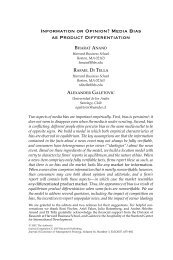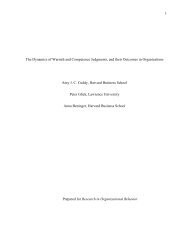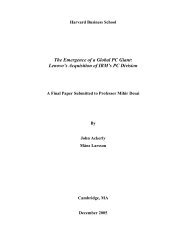The Demand for Tax Haven Operations - Harvard Business School
The Demand for Tax Haven Operations - Harvard Business School
The Demand for Tax Haven Operations - Harvard Business School
You also want an ePaper? Increase the reach of your titles
YUMPU automatically turns print PDFs into web optimized ePapers that Google loves.
e better able to relocate profits to larger tax haven countries since they have more substantial<br />
operations in these environments and there<strong>for</strong>e high profit rates are less likely to attract the<br />
suspicions of tax authorities. <strong>The</strong> regressions reported in Table 4 are run using observations only<br />
from parent companies with tax haven affiliates; the dependent variables in these regressions are<br />
the shares of tax haven activities located in the Big 7 countries. Columns 1 and 2 of Table 4<br />
report estimated coefficients from Tobit regressions in which the dependent variable is the<br />
fraction of tax haven affiliates located in the Big 7 countries. <strong>The</strong> sample consists of<br />
observations of parent companies with haven affiliates and covers the benchmark survey years of<br />
1982, 1989, 1994 and 1999. Column 1 reports a 0.1065 estimated coefficient on the log of nonhaven<br />
sales, and a –0.2546 coefficient on the log of parent sales, which together imply that larger<br />
parent firms, and those whose <strong>for</strong>eign affiliates contribute smaller fractions of total sales,<br />
concentrate less of their tax haven activity in Big 7 countries.<br />
<strong>The</strong> regression reported in column 2 adds the same explanatory variables as those used in<br />
the regressions presented in Table 3. <strong>The</strong> 3.6454 coefficient in column two indicates that ten<br />
percent higher <strong>for</strong>eign tax rates are associated with 36 percent higher desired fractions of tax<br />
haven affiliates located in Big 7 countries. <strong>The</strong> 0.9718 coefficient in the same regression implies<br />
that ten percent greater industry sales to related parties abroad is associated with ten percent<br />
higher fractions of tax haven affiliates located in Big 7 countries, and the 1.5325 coefficient<br />
indicates that ten percent greater R&D/sales ratios have somewhat larger effects. Very similar<br />
results appear in the regressions reported in columns 3 and 4, in which the dependent variable is<br />
the fraction of tax haven sales accounted <strong>for</strong> by affiliates in Big 7 countries.<br />
<strong>The</strong> results presented in Table 4 af<strong>for</strong>d a more nuanced interpretation of the tax haven<br />
demand specifications presented in Table 3. High <strong>for</strong>eign tax rates among affiliates outside of<br />
tax havens are associated with significantly greater tax haven concentration in Big 7 countries,<br />
which is consistent with the use of these larger tax haven countries to relocate taxable incomes<br />
through transfer pricing. Sales to related parties abroad and high R&D/sales ratios may present<br />
opportunities to use transfer prices to relocate taxable income, so the positive association of these<br />
variables with the fraction of tax haven activity in Big 7 countries is again suggestive of transfer<br />
pricing motives at work.<br />
10


